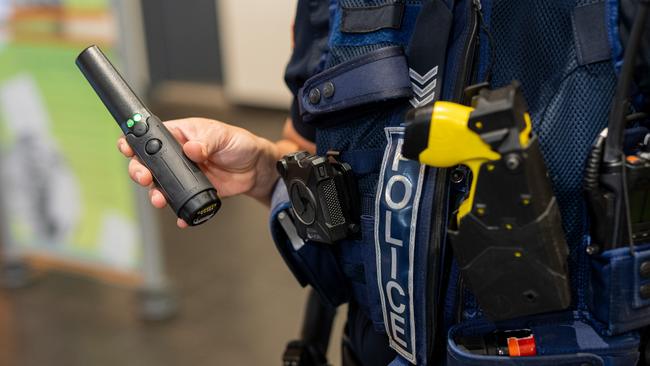Exclusive NT News analysis of violent crime puts police powers under the spotlight
The Territory government has been under increasing pressure to address violent crime but are the current strategies really making us safer? Read what an NT News deep dive revealed.

Northern Territory
Don't miss out on the headlines from Northern Territory. Followed categories will be added to My News.
The issue of violent crime involving edged weapons was thrust into the spotlight last year after 20-year-old bottleshop worker Declan Laverty was tragically killed in an alleged knife attack in March.
The collective grief sparked protests on the steps of parliament and a series of reforms that culminated in the Territory government’s knife crime reduction strategy, launched in August.
The strategy concluded that while weapons offences had risen in the past year, knives or other edged weapons were only involved in 5 per cent of violent crime.
“Any strategy to reduce knife crime must include a focus on violent crime holistically, to reduce a range of different violent crime types,” it reads.
But an NT News analysis of every case to proceed to sentence in the Supreme Court during a three-month period in 2023 reveals more than 60 per cent involved weapons of some kind.
The analysis covers every one of 93 serious, indictable offences involving violence finalised in the NT within that period* and shows 56 of them involved weapons.

Of those, 25 involved blunt weapons (including star pickets, rocks, sticks and other weapons such as baseball bats, hammers and even a guitar), while another 20 involved edged weapons (including various knives, scissors, machetes and other unspecified “edged weapons”).
Another eight offences involved glass bottles while three involved traditional weapons (spears, a ceremonial war stick and a nulla nulla) and one each involved a replica pistol and a car.
The weapons offences occurred overwhelmingly in population centres, including Darwin (22), Palmerston (nine) and Alice Springs (five), with two each in Tennant Creek and Yirrkala and a total of 10 across various other remote communities.
They were also overwhelmingly committed by adults, with just 11 involving youth offenders and the 80 per cent of the 42 involving adult offenders also involving drugs or alcohol.
Just nine of the offenders were women or girls, with men also more likely to be victims of weapon-involved violence (57 per cent to 46 per cent, including some offences with multiple victims).
Three quarters of violent offences involving a weapon were committed in a public place and more than two thirds were domestic violence related.
Griffith Criminology Institute researcher Janet Ransley said even though it might not feel like it for those living in hotspots, nationally violent crime, including armed robberies, was in decline.
Prof Ransley said what was increasing was detection of knife-carrying, thanks to aggressive strategies such as wanding introduced in Queensland and the NT last year.
But she said only “a very small proportion” of those who carry knives ever actually used them, “so there’s a very big difference between knife-carrying and using a knife in violent crime”.
“There’s very little Australian research about this but what the British research shows is that most young people who carry a knife grow out of it by the age of about 17 or 18, it’s a phase, most of them never use the knives,” she said.
“There is this very small proportion who go on to commit violent offences and that’s where the intervention strategies need to be directed.”
Prof Ransley pointed to a 2022 UK study which found “primary prevention” strategies “did not show a significant impact in reducing knife crime”.
“What they found is that none of the policing strategies make any difference, so stop and search in particular — and you could include wanding I think in that — doesn’t reduce knife carrying and they certainly don’t reduce knife related violence,” she said.
“There is some suggestion they might make it worse in some situations, if kids begin to feel targeted and therefore become defensive and less likely to comply with the law.”

Prof Ransley said her own research, conducted after wanding was first trialled on the Gold Coast in 2022, backed up the overseas findings in that “it didn’t reduce violent crime at all”.
“Although we found police got much better at detecting knives obviously, because the wands helped with that, there’s no evidence that it had any impact on violent crime,” she said.
“The whole rationale for the wanding was to reduce violent crime, it hadn’t done that, it had increased detection of knives, so over a longer period of time that might reduce violent crime.”
Instead, Prof Ransley said the British study had identified that “what does work” is understanding why people are carrying knives in the first place.
“What this study found was that these young people are most likely to come from backgrounds which involve drug abuse, violence, they’ve been victims themselves, mental health problems,” she said.
“So what is likely to work is individualised case management approaches that deal with those underlying problems which are hard, complex and expensive and which is why governments don’t like them.”
Prof Ransley’s comments were backed up by the NT News analysis which found 34 of the 56 armed offenders in the cohort suffered childhood traumas, including domestic violence, poverty, substance abuse and neglect.
Aboriginal Territorians were overrepresented in the NT News analysis, making up more than three quarters of total armed offenders, the vast majority of whom had suffered some form of childhood trauma.
And Prof Ransley said while the Griffith study, based on the 2022 Gold Coast wanding trial, found no evidence of racial profiling in the data, it raised concerns about how officers decided who to stop.
“You’ve got thousands of young kids out on a Friday or Saturday night, so we said ‘How do you pick which ones you’re going to wand? You can’t wand them all’,” she said
“The police should be given a lot better direction and criteria rather than somebody looks like they’re a gang member or somebody looks like they’re shifty.”
The NT Government introduced its own wanding legislation in July last year and since then robberies have risen from 19 to 40, down from a 12-month high of 49 in February.
Meanwhile, assaults have also risen from 866 to 1000 in November, the most recent statistical period available, down from a 12-month peak of 1109 in December last year.
NT Police’s most recent wanding operation was carried out on February 15 after reports of “adults fighting” at the Yeperenye Shopping Centre in Alice Springs while “armed with knives and an axe” on January 19.
Less than two weeks later, police also arrested a man after he was spotted in the Centralian capital carrying a samurai sword in public.
“Detection of weapons is vital to preventing and mitigating further offences of violence,” the operation notice reads.
“The use of handheld scanners is likely to be effective to detect and deter offences involving the possession of controlled and prohibited weapons in the Alice Springs high risk precinct. “Consideration has been given on the effect handheld scanners may have on lawful activity.”
NT Police acting Deputy Commissioner Martin Dole said “a number of weapons” had been confiscated “during such operations” but did not provide any specifics.

Mr Dole said the wands were otherwise available at officers’ discretion and they weren’t required to report their use, meaning no data was available outside designated operations.
He said officers were required to “complete an online training course” on the use of the scanners, covering human rights considerations and “their own unconscious bias”.
“(It covers) ability to assess risk and make decisions that will withstand public scrutiny (and) are ethical, lawful and fair,” he said.
“Equity in selecting candidates to STOP & SUBMIT, ensuring that members of culturally and linguistically diverse backgrounds are not singled out above others.”
Police Minister Brent Potter was also contacted for comment.
*A small number of offences may be omitted for legal reasons such as those subject to non-publication orders.
More Coverage
Originally published as Exclusive NT News analysis of violent crime puts police powers under the spotlight





